BUSINESS LOreal Tries On Smaller Packets for Size in India P
BUSINESS
L’Oreal Tries On Smaller Packets for Size in India
Packaging change shows how growth in the South Asian nation can be elusive and complicated
By PREETIKA RANA
Updated June 8, 2016 10:12 p.m. ET
MUMBAI—As Jean-Paul Agon, L’Oréal SA’s chief executive, drove around rural India—peeking into homes and stores last year—a harsh reality sunk in: Small is big in the South Asian nation.
The French cosmetics brand had been sticking with a marketing campaign aimed at India’s most affluent for years.
But after 20 years in India’s booming beauty and personal-care market, L’Oréal has had trouble pushing its market share higher than 4%, according to Euromonitor International. So the owner of Lancôme, Body Shop and other brands says it has now entered a new phase of peddling its products in India—selling smaller packets to poorer consumers.
L’Oréal’s transition to tinier packaging shows how growth in India—often hailed as one of the last great untapped markets—can be elusive and complicated.
It also shows how it will be years before it is profitable enough for companies to offset slowdowns elsewhere.
Unilever PLC, Procter and Gamble Co. and other multinational companies sparked what has been dubbed “the sachet revolution” back in the 1990s. They packaged shampoo and detergent in tiny plastic bags, hoping Indian consumers would snap up packets—which usually cost less than an nickel—and eventually upgrade to full-size versions.
That didn’t happen.
Indians now buy more sachet-size shampoos, conditioners and other products than regular-size products according to Nielsen, helping convince higher-end brands like L’Oréal they have to shrink sizes to have a chance at capturing a significant slice of this increasingly important market.
India’s Consumers Prefer Smaller Doses
L’Oréal adapting to market demand, has started offering its products in sachets
1 of 12fullscreen
L’Oréal’s hair color comes in a single-use pouch in India. The product, stacked next to a hair color bottle on the left, sells for 60 cents. The bottle costs $2.30. ERIC BELLMAN/THE WALL STREET JOURNAL
Ferrero SpA’s tiny Tic Tac breath mint box costs 7 cents. The regular-size box costs twice as much. ERIC BELLMAN/THE WALL STREET JOURNAL
Mondelez International Inc.’s best-selling brand of chocolate in India comes in a 7-gram bar for 7 cents. The larger bar sells for $2. ERIC BELLMAN/THE WALL STREET JOURNAL
L’Oréal SA’s shampoo sachet, right, next to a full-size bottle. The sachet is available for 45 cents and the bottle for $3.20. ERIC BELLMAN/THE WALL STREET JOURNAL
Unilever PLC retails a fingertip size jar of Pond\'s cold cream for 7 cents. The full-size version is available for $2. ERIC BELLMAN/THE WALL STREET JOURNAL
India’s ITC Ltd., part owned by British American Tobacco PLC, has shaved its cigarettes down to 2 inches. Cigarettes are sold in single sticks in India. The regular 3½-inch stick sells for 16 cents, while the two-inch version costs 7 cents. ERIC BELLMAN/THE WALL STREET JOURNAL
The U.K.’s GlaxoSmithKline PLC sells its Horlicks malt powder in a sachet worth 8 cents. The bottle is priced at $6. ERIC BELLMAN/THE WALL STREET JOURNAL
India’s Dabur Ltd. packs an ounce of honey in a tiny glass jar. The miniature bottle sells for 23 cents, while the bigger bottle costs $1.80.ERIC BELLMAN/THE WALL STREET JOURNAL
Unilever has packed its Surf Excel detergent powder in a sachet worth 3 cents. The bigger pack comes for $3.50. ERIC BELLMAN/THE WALL STREET JOURNAL
L’Oréal also sells tiny tubes of men’s face wash for 52 cents. The full-size version is priced at $2.50. ERIC BELLMAN/THE WALL STREET JOURNAL
Even hair oil is available in a sachet in India. This sachet of almond oil sells for one cent, while the bottle comes in at $3.70. ERIC BELLMAN/THE WALL STREET JOURNAL
PepsiCo has developed smaller packs and local flavors for its Quaker oats. Its Lemony Veggie Mix, available for 22 cents, is packed with vegetables and spiced with pepper, garlic, turmeric and curry leaves. The full-size version costs $2.60. ERIC BELLMAN/THE WALL STREET JOURNAL
L’Oréal’s hair color comes in a single-use pouch in India. The product, stacked next to a hair color bottle on the left, sells for 60 cents. The bottle costs $2.30. ERIC BELLMAN/THE WALL STREET JOURNAL
Ferrero SpA’s tiny Tic Tac breath mint box costs 7 cents. The regular-size box costs twice as much. ERIC BELLMAN/THE WALL STREET JOURNAL
More than half of India’s personal product sales by volume, last year, came from small packs, says Euromonitor. In China and Brazil, such small packs accounted for less than a third of sales volume. In the U.S. and the U.K., small-size servings make up less than a fifth of sales volume.
Last year, a quarter of the world’s 4.4 billion units of small-size personal-care products were sold in India, making it the biggest player in this market. Indonesia, which shares a similar demand for small packages, came a distant second with a 13% share of the global sales volume.
Traditional mom-and-pop shops still dominate the landscape in countries such as India and Indonesia, and the limited space in these tiny storefronts means it is easier to display sachet-size selection of products. Executives and analysts say India—the world’s second-most populous nation and where hundreds of millions of people live below $2 a day—is becoming a testing ground for new ideas.
“If it succeeds in India, there is a great chance it will succeed in other developing countries,” said Vijay Udasi, a senior vice president at Nielsen in India, referring to the country’s growing spread of shrinking products from candy bars to instant noodles.
ENLARGE
Unilever offers a fingertip-size pot of Pond’s cold cream, British Tobacco PLC’s Indian partner has shaved its cigarettes down to 2 inches, Coca-Cola Co. has halved the size of its standard bottle and one of Ferrero SpA’s best sellers is tiny Tic Tac boxes that hold less than 10 breath mints.
“You cannot exist,” if you don’t have a selection of small packets in India, said Jean-Christophe Letellier, the head of L’Oréal’s Indian business.
Small packs weren’t a prominent part of the company’s portfolio until a few years ago. Previously, Alain Evrard, then managing director for L’Oréal’s Africa, Orient and Pacific zone told The Wall Street Journal in 2007: “We don’t do poor products for poor people.”
L’Oréal now sells single-use sachets of L’Oréal Paris shampoo, tiny tubes of men’s face wash, and a petite pouch of Garnier hair color that sells for 60 cents. The company is rolling out more mini merchandise this month—a new range of 4-cent shampoo sachets infused with ingredients such as lavender and green tea. Mr. Letellier says L’Oréal had successfully established itself as an aspirational brand—out of reach of the average Indian—so it started to reach out to the mass market it had once ignored.
A visit to India by L’Oréal’s chief executive Mr. Agon in January 2015 helped solidify the move. On his previous trips to India, Mr. Agon typically visited city stores. But on this latest trip he went beyond city limits, stopping at shops in the smaller towns in the western state of Gujarat. He noticed that “very few stores would carry bottles,” said Mr. Letellier, who accompanied him.
L’Oréal’s smaller offerings are already paying big dividends. Small packs now account more than a third of its sales volume in India and its shampoo sachets and hair-color pouches are among its best sellers.
The French company is hoping to capture 150 million consumers in India by 2020, roughly four times its current base. L’Oréal’s early success in India’s sachet-sized market has also inspired it to introduce hair color pouches in Kenya and South Africa.
At the small mom and pop stores, the presence of L’Oréal products is pushing consumers to upgrade.
“Instead of moving from the sachet of [Unilever shampoo] Clinic Plus to the bottle of Clinic Plus, they would go from the sachet of Clinic Plus to the sachet of L’Oréal Paris,” said Mr. Letellier.
Rita Kumari, a nanny who earns $120 a month working for an Australian family in New Delhi, recently switched from a Unilever shampoo to a L’Oréal sachet. “The people I work for use this brand, so I wanted to try it,” she said about L’Oréal. “Wealthy people use this shampoo so I feel good about using it.”
Write to Preetika Rana at preetika.rana@wsj.com
After a Taste of Doing Business in Iran, P&G Is Eager to Re-Engage
With trade sanctions eased, company can renew its earlier push into expanding consumer-goods market
Iran’s market for consumer products will expand by about $100 billion by 2020, according to estimates. Shown, shoppers in Tehran. PHOTO: AHMAD HALABISAZ/XINHUA/ZUMA PRESS
By JOHN LETZING
July 13, 2016 5:30 a.m. ET
ZURICH—Like many Western firms, Procter & Gamble Co. is eyeing new opportunities in Iran following the relaxing of trade sanctions earlier this year. But for a Swiss subsidiary of the U.S. consumer goods giant, Iran already is a very familiar market.
Starting with market research in 2003, and culminating with more than $100 million in sales in the year ended in mid-2010, Geneva-based Procter & Gamble International Operations SA’s business in “Parthia”—an in-house byword for the Middle Eastern country—was a success story.
The operation relied on a legal exception. Until 2012, foreign subsidiaries of American firms could do business in Iran, as long as no U.S. passport or green-card holders were involved.
Internal Procter & Gamble International Operations documents reviewed by The Wall Street Journal provide a rare glimpse into the careful, behind-the-scenes efforts undertaken on behalf of U.S. companies to do business legally in Iran several years ago, amid the sanctions—which have barred trade, with limited exceptions. While sanctions remain in place, the exceptions have expanded, following Iran’s nuclear accord with the U.S. and other countries implemented in January.
P&G’s back story in the country of roughly 80 million people underlines why it, and other U.S. firms, are eager to re-engage. Future prospects also help: BMI Research estimates the Iranian consumer-goods market will expand by about another $100 billion by 2020.
A P&G spokeswoman said, “We are looking to increase the distribution of our existing brands and expand the portfolio of brands” in Iran, and making a related hiring effort.
ENLARGE
It will be revisiting a well-worn path.
More than a decade ago, after P&G’s Swiss subsidiary realized it could legally sell products such as Head & Shoulders shampoo in Iran at a premium, the business there was contributing to a broader company unit internally projected to reach $1 billion in annual revenue by 2015, documents show.
Other U.S. firms used the same exception allowing for business in Iran by foreign subsidiaries, such as General Electric Co. and oil-field services company Halliburton Co. But the difficulty in barring Americans from decision-making at such operations limited their numbers, experts say.
A GE spokesman said that while the firm made use of the exception in the past, it “stopped doing business in Iran well before 2012.” A Halliburton spokeswoman didn’t respond to a request for comment.
By the time the exception allowing foreign units to sell in Iran was ended in 2012, P&G had realized sanctions would tighten, a spokeswoman said. It already had stopped relying on the exception, and shifted to selling goods in Iran only under U.S. Office of Foreign Assets Control licenses; toothbrushes qualified as “medical devices.” The P&G subsidiary’s revenue in Iran, which reached $115 million in the fiscal year ended in mid-2010, tumbled to $15 million the next year, P&G has said in a public filing.
Now, the exception is available again. Cincinnati-based P&G says it won’t revert to its old model in Iran, though its Swiss subsidiary aims to increase sales in the country within OFAC licenses—which permit trade in eligible products that would otherwise be prohibited.
Though profitable, P&G’s historical reliance on a foreign subsidiary that barred Americans from selling products in Iran could also at times be tricky, said a person familiar with the matter. On at least one occasion, in 2007, an employee who disclosed having a U.S. green card had to leave a meeting concerning Iran operations, the person said. A P&G spokeswoman declined to comment.
Communications could be nuanced, too. A business update sent to European executive Werner Geissler in 2006 touted progress in markets including “Parthia.” The term was used interchangeably with “Iran” in internal documents, and traced its origin to an ancient region in the same area. A P&G spokeswoman said it is common practice at the firm “to use project names and abbreviations to simplify communications and manage confidentiality.”
A month after that initial memo, another containing a similar update was sent to American executives. It referred only to progress in “key Middle Eastern expansion markets.” A P&G spokeswoman declined to comment on the contents of internal documents.
In Iran, where P&G found women spend disproportionate amounts of income on beauty products, expensive shampoo and Braun epilators, the business “took off,” said Gregor Forbes, the former director of P&G’s Development & Export Markets unit, a part of the Swiss subsidiary which oversaw sales in Iran.
An early mission statement projected sales for Development & Export Markets could increase from $265 million in the year started in mid-2005, to $1 billion in the fiscal year ended in mid-2015, due partly to growth in Iran. For a global multinational with $56.7 billion in sales in the year ended in mid-2005, the Iran business was marginal, but promising. Top executives were interested in learning more.
In the summer of 2006, an internal proposal shows, P&G’s subsidiary arranged for Mr. Geissler to visit two selected women at their homes in Tehran. Mr. Geissler, who would later become special adviser to P&G’s CEO before retiring in 2014, was meant to engage with the women on questions such as: “How often do you wash your hair?” The proposal also advised on small talk to make with the women’s husbands about soccer. Mr. Geissler completed the trip, a person familiar with the matter said. Mr. Geissler didn’t respond to a request for comment.
Progress continued. A P&G consumer-research proposal from 2008 noted that Head & Shoulders and Pantene had gained solid footholds in the shampoo market, despite costing four times as much as local versions; and, one-quarter of Tehran’s estimated 1,200 gynecologists were being visited and asked to promote P&G’s Always feminine-hygiene products.
Mr. Forbes said expectations for the business were pinned to a belief that tensions between Iran and the West would ease. Instead, they worsened. “It was going to be a very different political atmosphere,” he said. “That didn’t happen.”
Mr. Forbes, who left the company in 2010, wondered if P&G would once again be able to ramp up a considerable amount of sales in Iran. “It has lost a number of years to the competition,” he said.
Write to John Letzing at john.letzing@wsj.com
QUESTIONS:
1. Why is Procter & Gamble looking for new business opportunities in Iran? What other opportunities are attractive?
2. What product sale did P&G\'s Swiss determine to be profitable in Iran?
3. What strategy did P&G\'s subsidiary use to do business for more than a decade in Iran?
4. How does P&G\'s subsidiary plan to increase sales in Iran?
5. Will this strategy work in other areas such as India and Pakistan?
Solution
1. P&G is looking for new business opportunities in Iran as the market presents itself with a lot of opportunities after the recent easing of the trade restrictions. The easing of trade sanctions means that P&G can now establish a presence in Iran’s expanding consumer goods market. The market for consumer goods products is fast expanding in Iran and P&G will now stand to gain from this. Secondly P&G is quite familiar with the market of Iran and hence it will be able to successfully do business in the country.
Other opportunities that are attractive are opportunities that are present for the company in other Middle Eastern countries. The company can well establish and expand its presence in other Middle Eastern countries where the market is highly lucrative and fast expanding.
2. P&G determined the product sale in categories like beauty products, premium shampoos, and epilators to be profitable. The company established its foothold with products like Head and Shoulders and Pantene.
3. The strategy that P&G’ s subsidiary used to do business in Iran was to make use of a foreign subsidiary when sanctions was in place. For Iran the company did its business through its Swiss subsidiary so as to take advantage of the exception that allowed U.S. firms to do business in Iran only through their foreign subsidiaries. This exception was used and P&G prices its products at a premium in Iran.
4. P&G’s Swiss subsidiary plans to increase its sales in Iran by making use of the OFAC licenses and trade in eligible products. The subsidiary will focus on selling those products on which the Iranians spend high amounts.
5. No this strategy will not work in other areas like India and Pakistan as consumers in these countries look to buy ‘value’ products. They prefer buying products that will maximize their value and do not prefer to pay premiums for a product. P&G, in these two countries, will have to tweak its strategy in order to be successful.
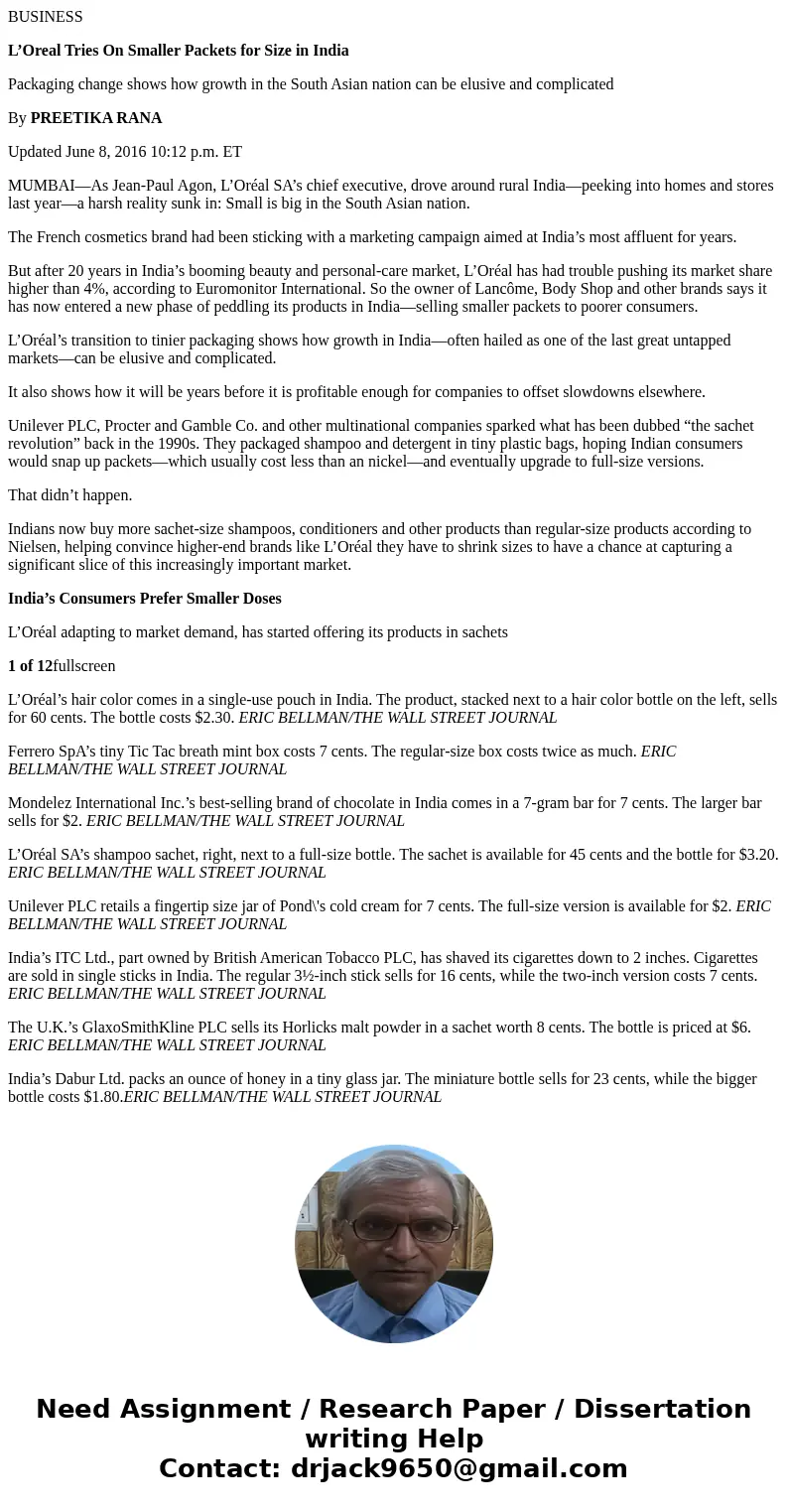
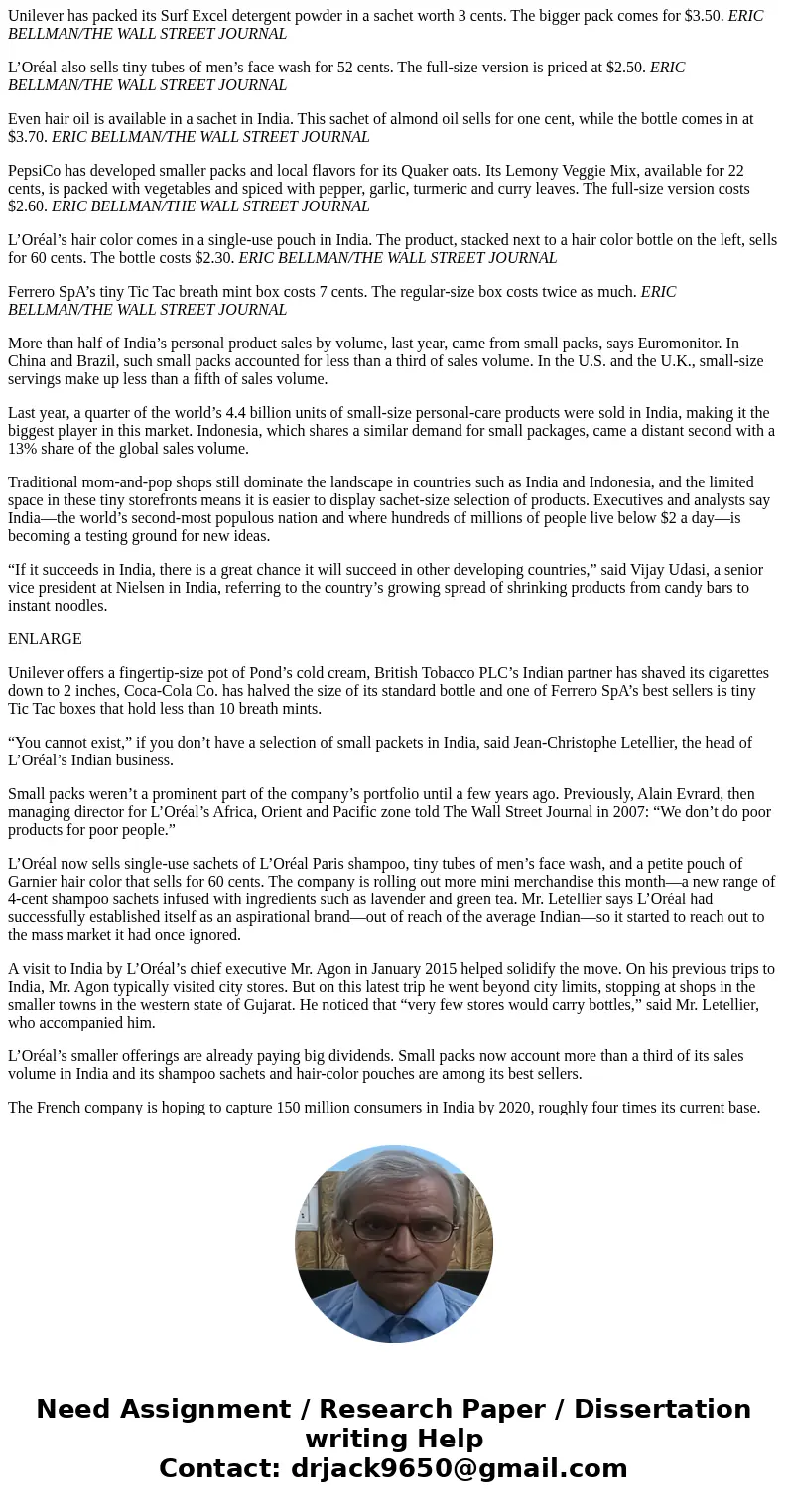
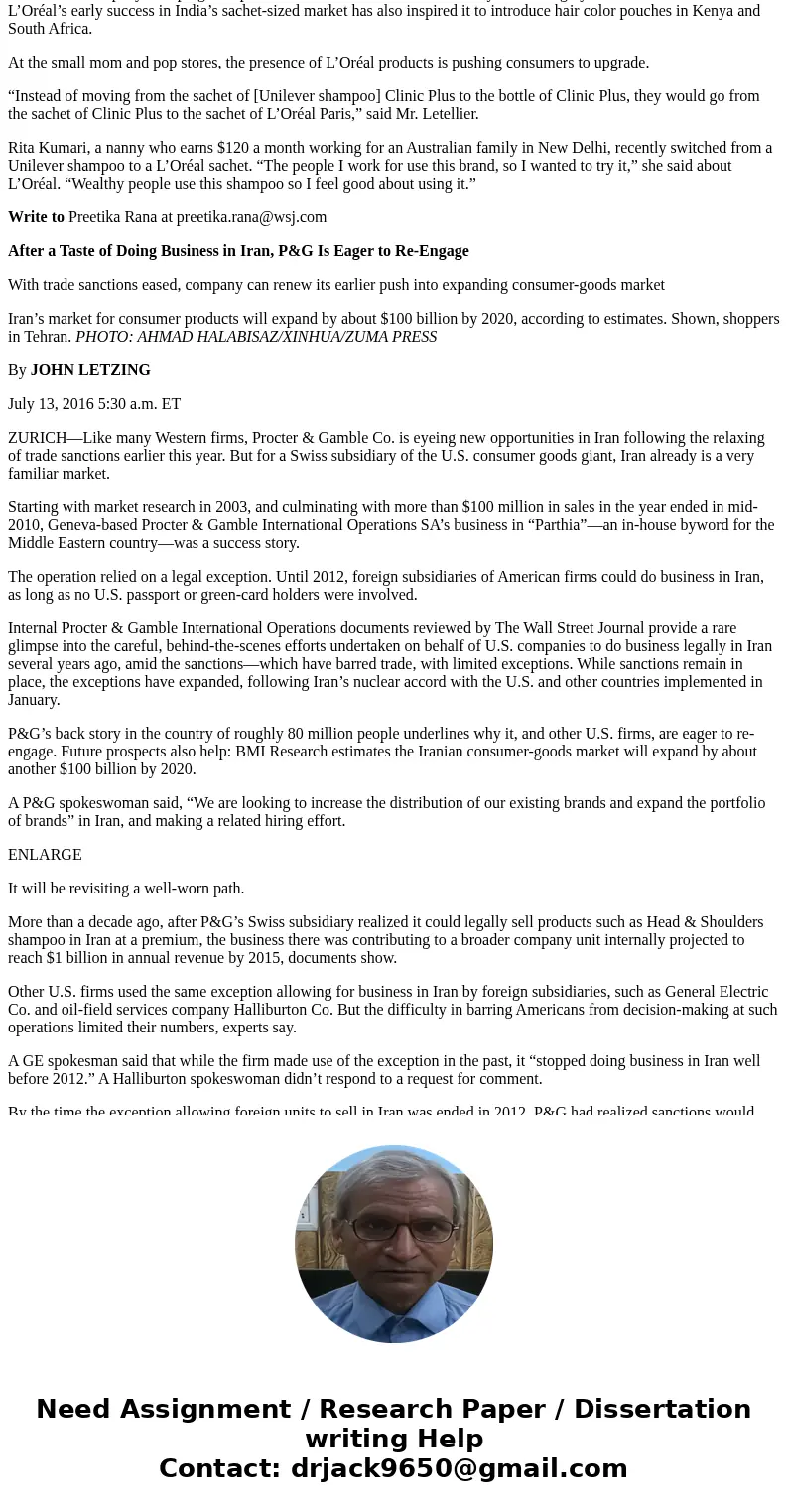
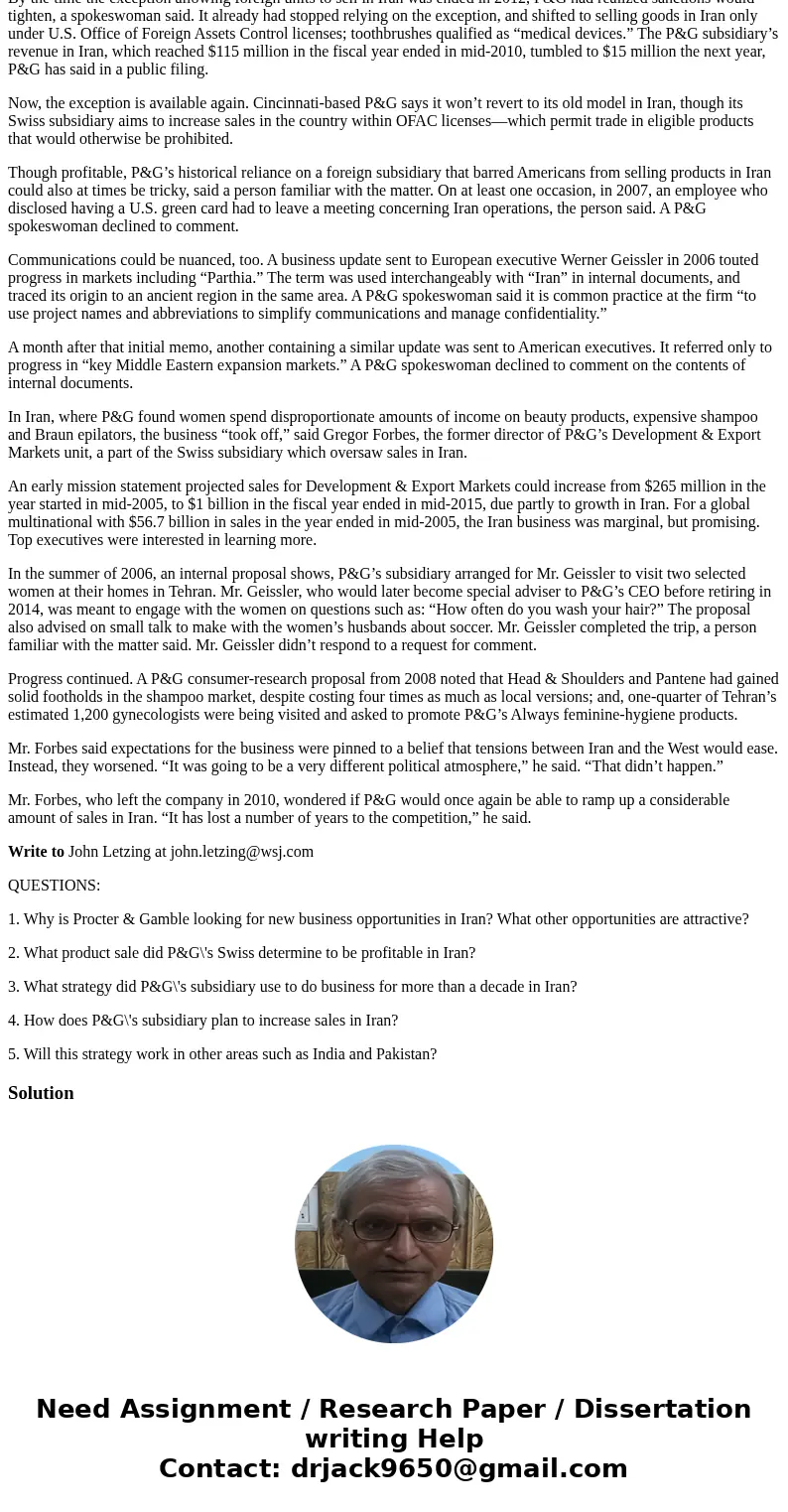
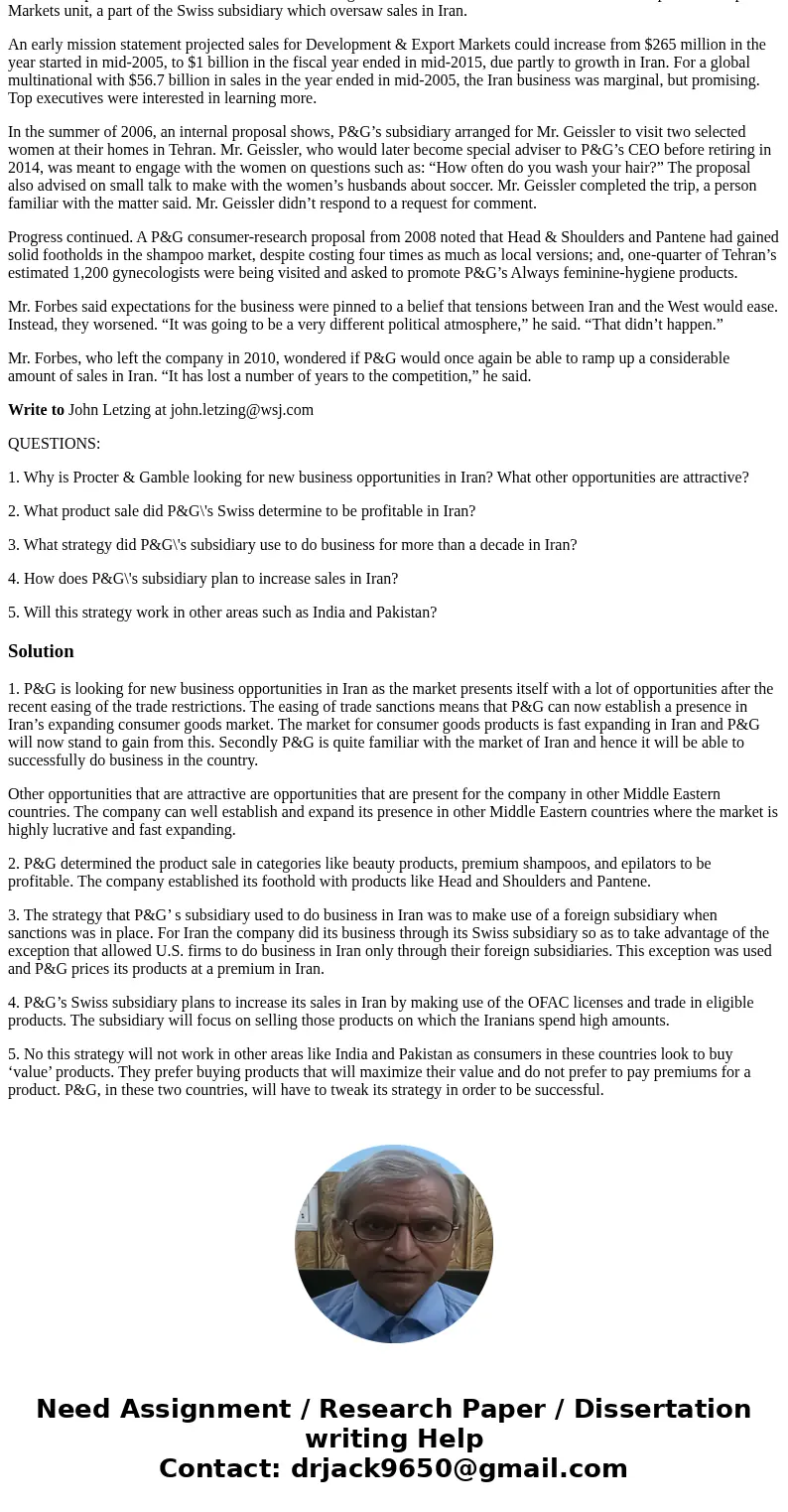
 Homework Sourse
Homework Sourse